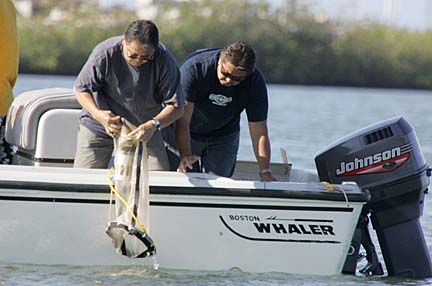
|

Experts are on a quest to
identify the tiny stinging jellyfish
that could be a new species
The tiny jellyfish that have been stinging canoe paddlers in Keehi Lagoon could be members of an undiscovered species, some local experts said yesterday.
The creatures may have lived in Keehi Lagoon all along and never blossomed to current numbers. Or they may have gotten transported to Hawaii from another place.
But there doesn't seem to be any scientific record of them in Hawaii, the experts said.
University of Hawaii coral specialist Cindy Hunter and Bishop Museum invertebrate zoologist Lu Eldredge have not been able to identify the creatures any more precisely than to say they're members of the hydrozoa class of jellyfish during the free-swimming stage of their lives.
That's the same conclusion reached Monday by Jerry Crow, curator of the Waikiki Aquarium, and Susan Brown, a UH plankton researcher.
The Hawaii scientists are e-mailing photos of the creatures to jellyfish specialists outside Hawaii to see if they can find a match.

|
Eldredge said he checked the Keehi jellyfish against examples of Pacific hydromedusae jellyfish, without a match.
Hunter said she received an e-mail from one respected expert who didn't recognize the jellyfish but promised to study it further. "And I looked through all the Hawaii-published literature and global literature and wasn't able to find a match," Hunter said.
One of the jellyfish could fit its bell-shaped body on the head of a pin, but you still might not see it because they're clear and gelatinous, Eldredge said.
Photographs taken under a microscope by Brown show that the creatures' bodies and four tentacles are transparent. The only coloring on the animals are small brownish areas at the base of each tentacle, which Eldredge said could be sexual organs, and the mouth and digestive area in the center of the body.
"This is probably as big as they get," Eldredge said, "because this group of animals has two forms in its life cycle. The attached form, called a polyp, and the jellyfish stage called medusa."
"We know a lot about the polyp stage, when they're attached" to a plant or the ocean floor, he said. "We know virtually nothing about the free-living stage.
"It's very possible this is something brand-new," Eldredge said.

|
The presence of the jellyfish have forced Oahu canoe racing associations to relocate Keehi summer regattas.
On Sunday, Hui Wa'a canceled its regatta because of the stinging problem, the first cancellation for non-weather reasons in its history, its leaders said.
A culprit that is a part of nature isn't so easy to deal with, said Watson Okubo, monitoring supervisor for the state Department of Health Clean Water Branch.
"We can't get rid of a jellyfish -- that's obvious," Okubo said. "We can't poison it or get rid of it. We just have to live with it, like you live with sharks."
Okubo planned to break the news to the Hui Wa'a canoe racing association yesterday at its monthly meeting.
"We can't tell them what to do. We can just give them the facts, that's it," he said.
Once the creatures are positively identified, the Health Department will consider whether to post a warning sign at Keehi Lagoon, but not before then, Okubo said.
Meanwhile, a woman who swam at Kaimana Beach on Sunday said she was "stung like crazy" by something there -- and wonders if it could be the same thing.
Margaret Murchie said she is asking the Waikiki Aquarium's Crow to check it out, but Crow couldn't be reached for comment yesterday.
Today Hunter expects to take college students with her to collect water samples in Kaneohe Bay and examine them under microscopes -- just to see if there's anything like the Keehi jellyfish out there.
|
E-mail to City Desk
[News] [Business] [Features] [Sports] [Editorial] [Do It Electric!]
[Classified Ads] [Search] [Subscribe] [Info] [Letter to Editor]
[Feedback]
